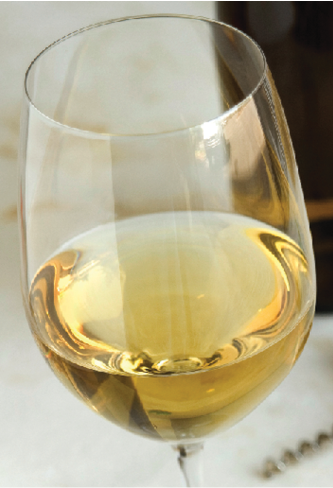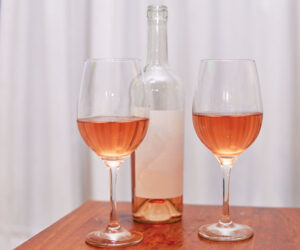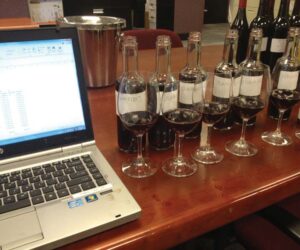Q
I have a 2011 Chardonnay from California fermented out to dryness. I added malolactic culture during alcoholic fermentation but it did not complete. The pH shift was from 3.38 to 3.52 after eight weeks. I then racked it and added sulfites. I did a chromatography test and it showed that there was still some malic acid present. I have heard about using lysozyme to stop any restarting of malolactic fermentation. What do you suggest?
Fritz Bango
Via email
A
In my day job in Napa, California (as Winemaker for Garnet Vineyards as well as other consulting projects) I bottle plenty of “partial ML” Chardonnay every year and love the style. In fact, my Garnet Vineyards Sonoma Coast Chardonnay is about two-thirds malolactic complete, depending on the natural acidity of the year (lower acid years may only be 50% complete) and none of my Chardonnays, even Russian River or Santa Barbara Chardonnays, are ML complete. Not having tasted your wine or knowing any other numbers like Total Acidity (TA) or alcohol, it seems to me that a bottling pH of 3.52 is a perfectly reasonable balance point between crispness and roundness.
It seems like you are willing to bottle a partial-ML Chardonnay and kudos to you. So many of we winemakers in California and elsewhere are doing so that I think we are seeing a nationwide paradigm shift in Chardonnay making. We are collectively tossing aside the fat, greasy and over-oaked concoctions of the past for a style where the satisfaction in the tipple comes from the balance of inherent elements and the fresh charm of the Chardonnay fruit itself.
As such, if you are planning to bottle soon, I advise you to not bother with the lysozyme but make sure your free SO2 is around 30 ppm, use a sterile filter (0.45 micron nominal) and use obsessively-clean sanitation before and during bottling. If a filter like one of the small models suited to home winemakers (like the Buon Vino, www.buonvino.com) is an expensive proposition for you (they run about $300 and up) see if you can rent one from your closest home winemaking or homebrewing supply store, or borrow one from a local winemaking club. Excluding bacteria that can eat malic acid and turn it into lactic acid is the only way to make sure you don’t get re-fermentation in the bottle.
Sometimes sold under brand names “Lysovin” “Lysoeasy” and “Lactizyme,” lysozyme is a naturally-occurring enzyme isolated from egg whites and has been used for decades in the dairy and pharmaceutical industries worldwide. It is a protein (as all enzymes are) that suppresses the activity of gram-positive bacteria. In real-cellar terms, this means that it’s effective against most strains of lactic acid bacteria (AKA “LAB,” Oenococci, Pediococci and Lactobacilli species are the most well-known), but not yeast or other winemaker bugaboos like acetobacter. Available in liquid or powdered form, it is usually dosed into wines at 100–500 ppm level and can be used at any point in the winemaking process. It is deployed for specific reasons, usually to enable primary fermentation in must infected with rot (allows the yeast to better compete), to delay MLF in red wines undergoing microoxygenation (high CO2 levels from MLF reduces micro-ox’s effectiveness) or to halt an unwanted spoilage LAB infection in ML-complete or partial-ML wines during aging. See Tim Patterson’s 2002 article, “It’s Lysozyme Time” at for an expanded viewpoint of what lysozyme can — and most importantly — can’t do for your wines during all stages of winemaking.
With regards to lysozyme cautions as regards bottle-ready wine, first let me say that it is not a magic bullet. If lysozyme kills lactic acid bacteria then can it be a complete substitute for SO2 and sterile filtration in managing lactic acid bacteria refermentation post-bottling? In a short answer, no. First of all, lysozyme is not an antioxidant so will provide none of the protection against browning that SO2 does. This is especially important in white wines as you want to make sure your wines age gracefully. Secondly, lysozyme’s activity is not persistent, meaning that it wears off over time, usually about two weeks, depending on the number of microbes present and the amount added to the wine. This means that unless you add lysozyme very close to bottling, the activity will be diminishing as you go to bottle and some microbes might get through. Adding lysozyme close to bottling can be fraught with difficulty, however, because as a protein it can flocculate and cause a white wine to become heat-instable. Because it’s a protein it can also strip color from red wines so is usually counter-indicated in light-color varietals like Pinot Noir. Additionally, some strains of LAB are resistant to lysozyme so its use is no guarantee.
That being said, if you have absolutely no access to a sterile filter setup, a little lysozyme treatment is better than nothing. Try dosing in lysozyme at a rate of 400 ppm and rack after two weeks. If having a heat-stable (no protein precipitation) white wine is very important to you, fine with bentonite afterwards (about two weeks apart as bentonite and lysozyme can work against each other) at a higher rate than you normally would for bottle-prepping. Adjust your free SO2 to 50 ppm like usual, maintain the strictest of sanitation regimens as you go to bottle, and cross your fingers. Be sure to let 24 hours elapse between any lysozyme and SO2 additions; their activity can cancel each other out.
Q
In the April-May 2012 issue there was a question in “Perry Problems” regarding sugar adjustments. Your answer mentions cane sugar, beet sugar and malt sugar. I have always used cane sugar or fructose to make adjustments. I was told the molecular structure of vegetable sugars don’t blend or marry well with fruit alcohol. Is this true, or are all sugars the same?
Daniel N. Bazzoli
Calistoga, California
A
Cane sugar, or sucrose, derived from the sugar cane plant, has a chemical structure of C12H22O11, is a di-saccharide comprised of the mono-saccharides glucose and fructose and is found in many plant sources, most well-known being the aforementioned sugar cane plant, the sugar beet root and sap from the maple tree. I think you mean “sucrose” when you say “fructose” in your letter. Your general grocery-store bag of white table sugar is probably made from either sugar cane or sugar beets and according to industry sources is about 99.50% pure sucrose. The 0.5% difference is the difference in minerals etc. between the beet and the sugar cane source, but I’ve never experienced any difficulties in winemaking because of this. Malt sugar, or maltose, actually has the same chemical formula as sucrose (C12H22O11) but it is made up of two glucose molecules hooked together (instead of a glucose + a fructose molecule) and is less sweet than sucrose. It can be purchased in granular or syrup form, the latter being easier to dissolve into liquids.
I used to work at Bonny Doon Vineyards in Santa Cruz, California and though I can’t give away any company secrets here, I will tell you I had copious experience over the years mixing vegetable sugars (from sugar cane) with fruit alcohols as my crew and I concocted some of Randall’s well-regarded and commercially-successful fruit-based dessert wines and never found the sugar and fruit alcohol to have problems.
You may be referring to the issue of solubility of sugars, or their ability to dissolve into liquids, when you mention incompatibility above. The higher the alcohol and the lower the water content of any given liquid, the harder it is for sugar to mix into it completely. That’s why it is often best to use superfine sugar (also called “baker’s sugar”) or a sugar-simple syrup (dissolve granulated sugar of any kind into a small amount of hot water) when making wines, especially those that are higher alcohol.
Whether sucrose comes from corn, beets or sugar cane, it is all pretty much the same. However, not “all” sugars are the same. For me, the biggest differences between sugars come with either their relative sweetness (i.e. have to use more agave nectar or maltose to achieve a higher level of sweetness) or especially their “add on” flavor and aroma characteristics. Brown sugar, for example, will always lend a “caramelized” and possibly a burnt note to wines because of the residual molasses content though it will ferment just about like sucrose will. Honey, maple syrup, malt syrup, birch syrup . . . the list goes on and on and my rule is to add carefully, because these natural products will often differ in their sugar content (measure potential alcohol as you go) and to be darn sure you love the taste of what you’re adding because it will most likely stick around (or stick out like a sore thumb) in your final product.
For most winemaking projects where I have to ferment added sugar, I actually will prefer to use grape juice concentrate (red or white, depending on my desired end results) which can be purchased from winemaking supply stores as well as commercially. Be sure to ask the manufacturer what the sugar concentration is so you can better gauge how much you should add and how much to buy. Grape concentrate carries several advantages over white table sugar in early-stage winemaking. I find that the flavor marries well in the fermenter and additionally the fruit concentrate provides a wealth of nutrients, vitamins, and minerals to support a healthy fermentation, which sucrose alone simply doesn’t have. If you buy red concentrate you are further supporting the color of your red wine and even white concentrate can help to provide better body, structure and acid in the wine, which sucrose simply will not do. Further, for those who make wine to sell it in the real world like I do, there are different rules governing what you can and can’t do. For instance, here in California winemakers are only allowed to add grape-juice concentrate to “table wine,” though if you have special-formula dessert wines you can sometimes add other types of sugar. I always recommend to readers, if they can find it and afford it, to use grape juice concentrate to sweeten must or juice when you will be fermenting that sugar.
For adjusting the final sweetness of homemade wines (whether it be grape or fruit based, dry, sweet or dessert-style) I would be tempted to use the superfine “bakers sugar” because it is guaranteed to not give any funky herbal or burnt aromas, dissolves well and is relatively inexpensive. Do not, however, confuse it with powdered sugar (sometimes called “confectioner’s sugar”) because powdered sugar contains cornstarch and can really gum up your winery’s works. As always, if you are selling wine in the United States, check with an Alcohol and Tobacco Tax and Trade (TTB) compliance specialist (or their difficult-to-navigate website, ttb.gov) to be sure what you can and cannot add. If you only make your wine for you and your family and friends to enjoy, however, don’t worry about it! Go with what sugar sources taste best and work best for you.
Q
I am making an Australian Chardonnay kit with only half of the oak chips. I will be bottling it soon and would like to do a 3-gallon (11-L) carboy with the full amount of oak and the rest as I have made it so far. Will it pick-up the additional oaky flavors if held in the carboy for two or three months more before bottled? Should I put in one or both of the remaining packs of oak into this batch?
Tom Storm
Palmyra, Pennsylvania
A
First, make sure that the portion left over, i.e. the portion you are not bottling now and will be adding more oak to, will be stored in a completely full (or “topped up”) container. This is critical to protect wine, especially white wines, from the ravages of oxygen and aerophilic spoilage organisms. Now, on to how much more oak you should add and how much time it will take to notice the effects. You can always add more oak but you cannot remove it. For that reason, start with one pack, waiting two weeks and stirring and then tasting for oak flavor and aroma development. If you sense that this one pack is moving you in a positive direction, don’t add the second one quite yet.
I don’t know how many grams of oak chips are included in each “pack” you refer to, so it’s hard for me to give exact recommendations, so here are some general guidelines. In Chardonnays that are approaching bottle readiness, I find a 2 g/L oak chip addition will give a satisfying hit of oak without being too heavy, in about 6–8 weeks’ time. When using any non-barrel method of introducing oak into wine at any stage, remember these guidelines:
• The closer a wine is to being bottle-ready, the more an oak addition will have an impact on the wine. Be conservative when adding oak in the later stages of a wine’s life pre-bottle.
• The earlier in a wine’s lifetime you add the oak, the better-integrated it will be. This also allows you to add small amounts little by little, therefore avoiding over-oaking the finished wine.
• The smaller the oak particle, the faster the extraction time. Powders have an almost instantaneous effect. Big tank staves can take months to fully extract. Though a small particle may seem like the best option, I often find the best wine quality results in aroma and flavor come from using larger particles, like “segments” that are about two inches square, or even larger pieces sometimes packaged in oak “fans,” or small staves about 18 inches long, ¼ inch thick and 2 inches wide which are attached together at one end with a ring. A great all-around product for home winemakers (because they fit into a carboy neck or barrel bung hole) are the small cubes or “beans” about 1⁄2 to 3⁄4 inch on all sides. They give some of the nice “bigger particle” oak flavor while being easy to handle in the cellar.
• The higher the alcohol, the faster the extraction time. Ethanol is a far more powerful solvent of oak than water. Be cognizant that a Chardonnay of 15% alcohol may need about a quarter less oak extraction time than a low-alcohol white wine at 11%.
• Stir and taste periodically to monitor progress. You need to make sure that you stir up your container (minimizing oxygen contact) and taste regularly to get an idea what the oak is doing to your wine. Be sure you just don’t thief out a sample at the top of your carboy where the oak might be floating or you’ll get a false sense of a higher oak concentration. Judge how often you taste based on your oak extraction timeline. If you have added oak to a newly-fermented wine and have planned on aging it for many months, tasting monthly should be fine. If, like you, you’re doing a pre-bottling oak adjustment and especially if you have added an aggressive amount of oak, taste every five to ten days to make sure you are not over-oaking.
• Do bench trials. Sometimes toast levels will surprise you and you’ll find a high toast product actually is the perfect thing for your Chardonnay. You may love American oak on your Zinfandel but hate it on your Viognier, or vice versa. For oak trials, I use 375 mL sample bottles and try to weigh out 2, 4 and 6 g/L amounts of my oak product and add to the wine, letting it sit for a week. Though these are higher doses than you will probably put in your finished wine, with a week’s contact time it will allow you to see in which direction that oak product is taking your wine.







